-
Posts
2,631 -
Joined
-
Last visited
Posts posted by AnthonyB
-
-
If the flats each have suitable fire separation then there is no need for a common alarm of any type where the communal space is a small ground floor lobby (the block can 'stay put'). I've assisted in a case with a similar set up to yours where the freeholder wanted to install a smoke alarm and emergency light for a ground floor lobby which also necessitated getting the Distribution Network Operator to put in a new supply as there was (understandably) no existing communal electricity supply. The leaseholder cost implications were horrendous, however as the flats had suitable separation then none of this was required.
If there is a serious concern with fire separation then a common system would be needed but it would have to extend into each flat to support a full evacuation policy. Such a system can be Grade D (domestic mains alarms with battery back up) in a building of up to two storeys, above that is Grade A (commercial grade fire alarm) - it's based on storeys not whether they are common or not.
Their duties under the Fire Safety Order don't go away - they have to implement the findings and if they intend to both ignore their responsibilities and let one of the flats then this would be a matter for the fire service in respect of the common issues and the local authority in respect of the rental property.
The FRA of course could be wrong in which case it needs rewriting, but there is also every chance it's spot on - I can't be sure from a computer keyboard! -
You'll not find anything specific detailing this, the law itself is very broad and functional with the risk assessment giving the detail based on a variety of sources of non binding guidance. Some stuff like this is also though to be so obvious and intuitive as to not need a detailed note requiring it!
-
1. Correct, no CE mark by itself is not a reason to automatically require replacement
2. Smoke control doors were a thing way before 2003, your FRA should determine what doors are expected, but for the size and age you'd expect FD30S
3. Your fire door inspector should have been able to tell if an intumescent letter box was in place. A spy hole is so small your risk assessor should determine in line with a competent fire door specialist if it's proportionate to investigate further.The biggest unnecessary overspend in existing blocks of flats relates to fire doors and in an ideal world a competent fire risk assessor and a competent fire door inspector would meet together and with the client to assess on a risk based approach as per the legislation what must be done promptly, what can be done over time progressively and what really isn't necessary. The most important thing is that the doors are all self closing flush in frame.
A lot of places have taken advantage of fire door inspection requirements so have trained staff on a pass/fail modern standards basis only whereas the legislation & it's official guidance does allow a risk based approach - this means you need to choose carefully your fire door inspectors & risk assessors. -
Unfortunately signing off of a building has no relevance as to whether the work is to a suitable quality or effective standard as they aren't carrying out inspection to any level of detail - the liability always rests with the developer. The biggest example is Grenfell Tower which got it's refurb signed off. I wouldn't buy anything from the last 25 years or so due to all sorts of common defects, particularly a house.
Intumescent strips and FD30 doors (where a dwelling size and layout requires any fire doors in the first place) are not a new thing and it's a long time since 'FD20' doors (often an FD30 door with no seals after purpose built FD20 doors were no longer made) were a thing: https://www.thefis.org/2022/05/30/fire-door-safety-alert-clarification-around-fd20s/
Third party certified doors aren't explicitly a legal requirement, but how else can you be sure they are compliant and it's usually expected for new installs.
Intumescent seals don't stop smoke detectors working as they don't stop smoke and only swell up to fill the door gap until the fire is very hot and well developed -
I wouldn't, it usually only leads to unnecessary hassle & delay, just call it maintenance and not making things worse than original. If it's a hospital subject to the BSA you have no choice. That's the honest answer although you will get the BCI's in here making a fuss about it!
-
Is that really the only way in & out of the building? Or does the stair lead to a normal main entrance which in most single stair flat buildings would be the only designated exit?
-
That's rather excessive - you don't need fire exit signs in simple single stair single exit buildings & glazed framed pictures and plant pots (as long as the plants are kept watered and alive) are not usually a real hazard (I'm usually happy with them).
Smoking signage is an explicit legal requirement with no get around - however the requirement for it to be at least A5 with specified text was dropped (in England) years ago so a simple 75mm or 100mm no smoking pictogram by the entrance would suffice
Other signage can and also should be sympathetic - for a typical plant room or meter cupboard there are two ways of signing them that are compliant - one of which is less institutional
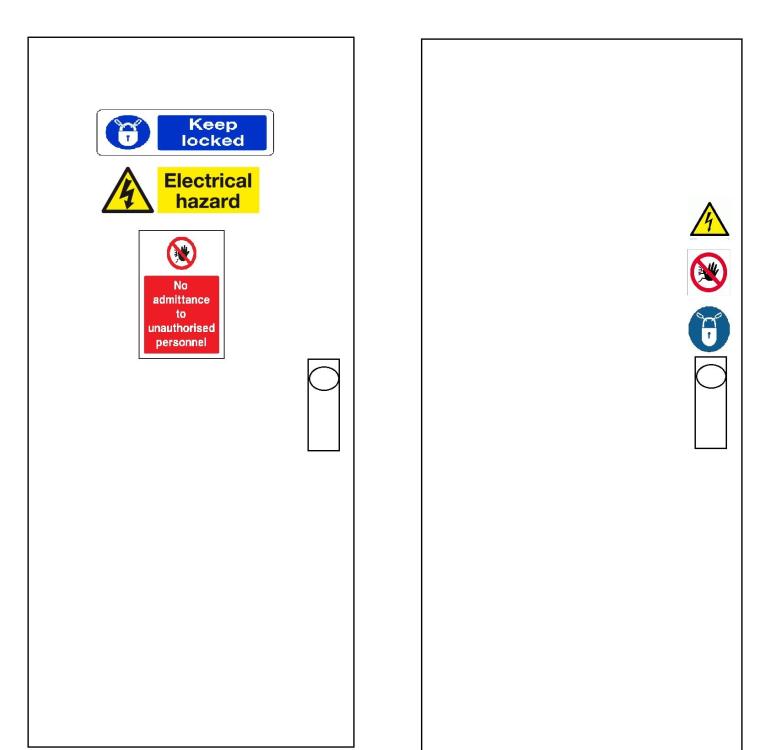
-
You shouldn't need to ask this as your risk assessment & assessor should automatically have updated you in the last two assessments.
Practically if no physical actions are outstanding and you have the right maintenance in place for fire door inspection, emergency lighting, smoke control, etc you are probably OK with the building, the biggest change is to resident information (which has to be annually provided to each resident & whenever a new resident moves in).
Currently you should be providing the following info, the bold italics being the newest stuff that many RP's aren't up to speed with yet:
Information that must be provided to residents includes:
• any risks identified in the fire risk assessment and what fire safety measures have been enacted to address this
• your name and UK address, the identity of anyone who assisted with doing or reviewing the fire risk assessment, as well as the identity of anyone who has been appointed to implement firefighting measures
• how to report a fire to their local fire and rescue service
• information on how to understand the ‘stay put’ strategy, and the action to take should they discover a fire in their own flat or in the common areas
• being made aware of the importance of maintaining their flat entrance doors and their self-closing devices where appropriate including that they should not tamper with them. That fire doors should be kept shut when not in use and that any faults or damage to the door should be reported immediately -
You are outside the scope of "A guide to making your small paying-guest-accommodation safe from fire" which would not require self closers as you have both 3 storeys and the stair opening into a habitable room rather than direct to exit or exit via a hallway.
Principles in the main guidance would see a protected stair and self closing doors and either exit via a protected corridor creating or an alternative exit route or suppression. As this is potentially too far an extreme in the other direction you need a happy medium, which as it's outside the guidance, is best done by a professional risk assessor with sector experience as your fire risk assessment will have to justify why the premises layout is acceptable despite being outside the guidance.
-
Usually at least 1kg, preferably 2l/2kg.
ABC Powder is the traditional go to as it's cheap, yet is still powerful compare with other agents mass for and is (almost) multipurpose. However it is messy and can damage surfaces and equipment (especially if warm or hot) and isn't pleasant to inhale. It's also ineffective on cooking oil fires.A more expensive but handy alternative is water mist, which is non damaging and effective on the main domestic fires of solids materials, electrical equipment and cooking oils
https://www.safelincs.co.uk/1kg-abc-dry-powder-fire-extinguisher-ultrafire
https://www.safelincs.co.uk/2kg-abc-dry-powder-fire-extinguisher-ultrafire/
https://www.safelincs.co.uk/britannia-2kg-powder/
https://www.safelincs.co.uk/1-litre-water-mist-fire-extinguisher-ultrafire/
https://www.safelincs.co.uk/britannia-p50-2ltr-water-mist/
-
They should, but as you have found out, enforcement is so 'hands off' & lax these days it has to be something horrendously bad before they will do anything.
-
On 26/06/2025 at 15:56, Eric90 said:
A converted 5 storey office block into residential flats, AOV to the top of the stairs and also mechanical extraction system in place to the flat approaches on all levels. The cross corridor doors to the flat approaches all have excessive gaps to the threshold, am I right in understanding that these are acceptable as they allow any smoke to be cleared out through the mechanical extraction system. Thanks
That depends on the design of the system, it's not a given. Usually the only time there are airflow gaps around fire doors is part of a pressure differential smoke control system as oppose to standard extract, but that's not to say it's not possible, although inlet air from the stair is usually by opening the door.
-
In theory it could be both - unfortunately security almost always overrides safety it seems, the security risk should usually be high enough to justify from not having the required failsafe's in the direction of escape.
-
It depends how small the cupboard is in order to fit a detector and barring that as an issue then it's down to the Category of fire alarm system required for the premises - If it's L1 or L2 then the cupboard should always have been covered.
-
As I assume you are talking about a commercial fire alarm system, then the NFCC advice is not applicable. 10 years is used to get people to replace equipment based purely on a single manufacturers recommended life span and warranty period. The appropriate British Standard for fire alarms has no lifespan as long as the equipment passes service. An independent scientific study where the Government were a stakeholder concluded (based on extensive tests and experiments) that, dependant on type, a detector can remain serviceable for 25-30 years.
As the system is approaching these limits it would be advisable to start gradually replacing the detectors now, thus spreading the cost of replacement over several years.
A fire marshal is only trained to assist in the evacuation of a building in a fire (after anything from just 30 minute to 6 hours training) and not in fire risk assessment so there is a risk anything they produced could fail to be suitable and sufficient for the purposes of the legislation. It is possible for Responsible Persons to do their own FRA, but they need to be in line with the accepted guidance - I would urge you review your in house assessment to ensure that is in line with the appropriate guidance which is here https://www.gov.uk/government/publications/fire-safety-risk-assessment-small-and-medium-places-of-assembly If it follows this and meets the guide then it should be OK - remember the risk assessor is legally liable in addition to the premises Responsible Person if the FRA is substandard, however the fire safety legislation does state that if you have followed the linked guide you can be deemed to have complied with the law.
If you do decide to use an external specialist ensure the actual assessor are registered here https://www.firesectorfederation.co.uk/fire-risk-assessment/fire-risk-assesment-directory/ and is not from a fire protection company to avoid a conflict of interest. -
If they are shunt ducts they are designed to reduce fire and smoke spread - if not and are directly ducted it's not considered practicable to retrofit new ducting or dampers but for bathrooms a more simpler intumescent grille is considered adequate, this would be more so in a hotel that simultaneously evacuates unlike flats.

-
There is an anomaly in the fire door guidance in Building Regs Guidance (which whilst not directly applicable to legacy buildings is often used as a benchmark in lieu of any other specific guidance) where a door protecting an escape route should be FD30S but a door protecting a riser/plant room/electrical intake need only be FD30 and often causes arguments where the riser/plant/intake also opens directly onto an escape route - some will say the higher standard of FD30s should apply to protect the escape, others will fall back on the fact these rooms are specifically detailed as only needing FD30.
If you are renewing anyhow the cost of using a combined intumescent fire & smoke seal compared to intumescent only is negligible enough to go down that route for the added protection.
It would be a few months before I'm anywhere near that part of London & whilst I could do a specific trip down it would be at a premium due to absorbing the overheads in one fee rather than the usual planned road trip of multiple jobs. -
If you are under 300 sq.m. then a single zone for the whole building or over more than one storey is compliant, the only exception would be a HMO or Sheltered Housing where zoning per room/dwelling is recommended regardless of the size. A non Building Regs flat conversion can be classed as a HMO under s257 of the Housing Act if at least two thirds rental, but this is mainly an administrative definition to allow these premises to require licensing should a council wish to as part of an additional licensing scheme and not for specific fire precautions reasons. It can be beneficial to zone further but isn't needed to meet BS5839 recommendations so unless an addressable system (which can easily and cheaply be rezoned by programming) I wouldn't bother as you would need recabling.
The reason for heat detection on flat hallways is to prevent the whole building being disrupted by false alarms that could be generated by smoke detection as the common system is to protect people in the rest of the building, not the flat of fire origin. In this case each flat would still need local smoke alarms to protect the flat residents - a false alarm in these would only disrupt the flat causing it. It's possible for a common system to do double duty by having a smoke instead of a heat and no separate local smoke alarms - if there are no false alarm issues then this is fine. -
Your upgraded cupboard sounds of suitable construction dependant on the edge sealing and thickness of boarding, sounds a bit OTT. London is a bit far but I do have a client with some sites down that way depends where it is in relation to them.
-
What exactly is wrong with the existing installation - nothing substantial has changed to require retrospective application of standards - also, are the consumer units still plastic or are they now in their own 'non combustible housing' i.e. metal as per modern wiring standards? If the latter it reduces the reliance on the cupboard and in some cases my clients have found it easier and cheaper to change the electrics than the cupboard.
-
On 12/06/2025 at 13:33, Beth Morrison said:
Hi Everyone,
Reading through the various different legislation, and have become stumped. We have student housing - over 11 metres in height, whereby a Flat Door then has a cluster of 4 separate bedrooms inside.
Currently, each individual bedroom door is being checked annually by a Fire Door professional in addition to the Flat Entrance Door and Communal doors.
My query is - do the internal bedroom doors really need a professional annual check or can these just form part of the checks maintenance staff? The cost is becoming quite significant
Thanks in advance,
A suitable system of maintenance is required by the legislation, your FRA should determine the frequency. The Government never intended the cash cow of every inspection being a full in depth check - this is detailed in the guidance to the Fire Safety (England) Regulations. Usually where the doorset has been established by specialist inspection to be fully compliant the wear & tear checks can follow the style of the FS(E)Checklist and can be done in house although some basic training is recommended. Professional checks would still be of use if there have been any alterations or changes, any issues found on the in house checks where 'seek professional advice' is the result and every few years as a backstop
-
Fire doors are seen as a cash cow and many smaller blocks are suffering from unnecessary burdens to the lease/common holders due to incorrect advice on doors that does not follow Government guidance. In many of these blocks the original fire doors remain suitable as long as in good order and the only critical issues are related to doors not self closing properly/at all or doors replaced by non fire rated doors.
-
On 11/06/2025 at 13:26, Guest Michael Sealey said:
Hi ,
I'm after some advice - with completing a fire risk assessment for a medium sized high street retail unit , with private residents above ( not our demise.)
We have one main entrance/ exit door & one fire exit to the rear. I've been advised to discount the main entrance / exit for travel distance calculations - meaning we now technically have one fire exit , and thus single direction . Is this correct , or do we calculate travel distances with all doors included ?
Thanks
Sounds like you may need to use a professional risk assessor if you aren't sure - but in essence travel distances and exit capacities are different issues. If you have two or more exits (that meet the 45 degree rule or are separated by fire resisting construction) you can use the Travel distances listed for more than one direction of escape (but be aware that initial dead ends where you can only go one way must meet the single distance up to the point that routes diverge).
Then you need to ensure the number and width of exits is enough for the occupancy - you always discount the widest exit for this just in case the fire blocks access.
The extract in the above reply is fro Approved Document B, a design guide under the Building Regulations for new premises - existing ones should use this - https://www.gov.uk/government/publications/fire-safety-risk-assessment-offices-and-shopsUseful extracts:
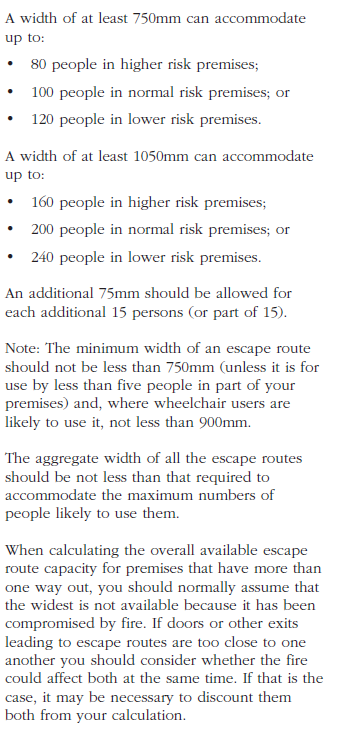
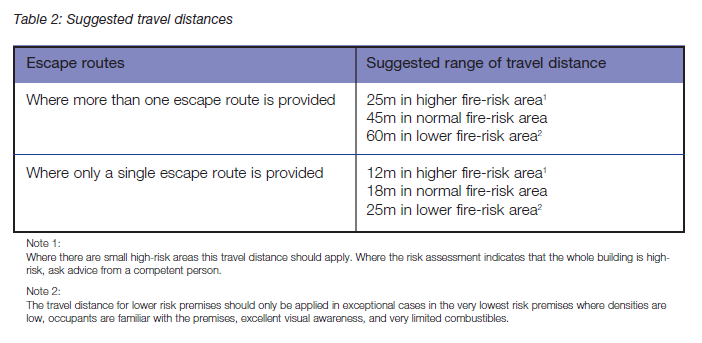
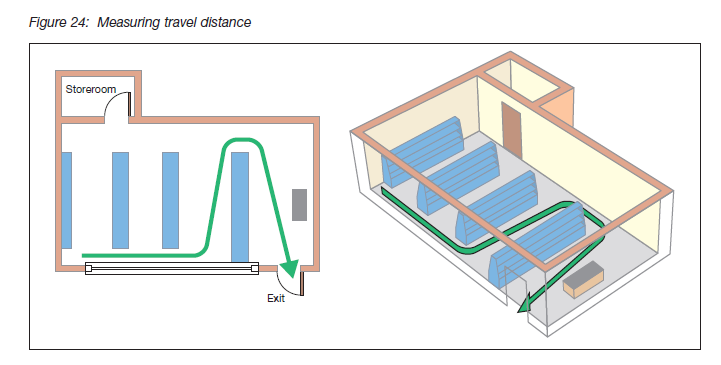
-
13 hours ago, Guest Mr Chris said:
Thank you Anthony for that valuable information and referral to the guide. I would presume that fire doors are definitely required for the 2 gf flats despite their not opening direct to the stairs? They open to the gf lobby area with the stairs off that. Many thanks, again. The four flat owners are the freeholders and we manage the block ourselves
Possibly, but without seeing it for myself I can't be definitive.

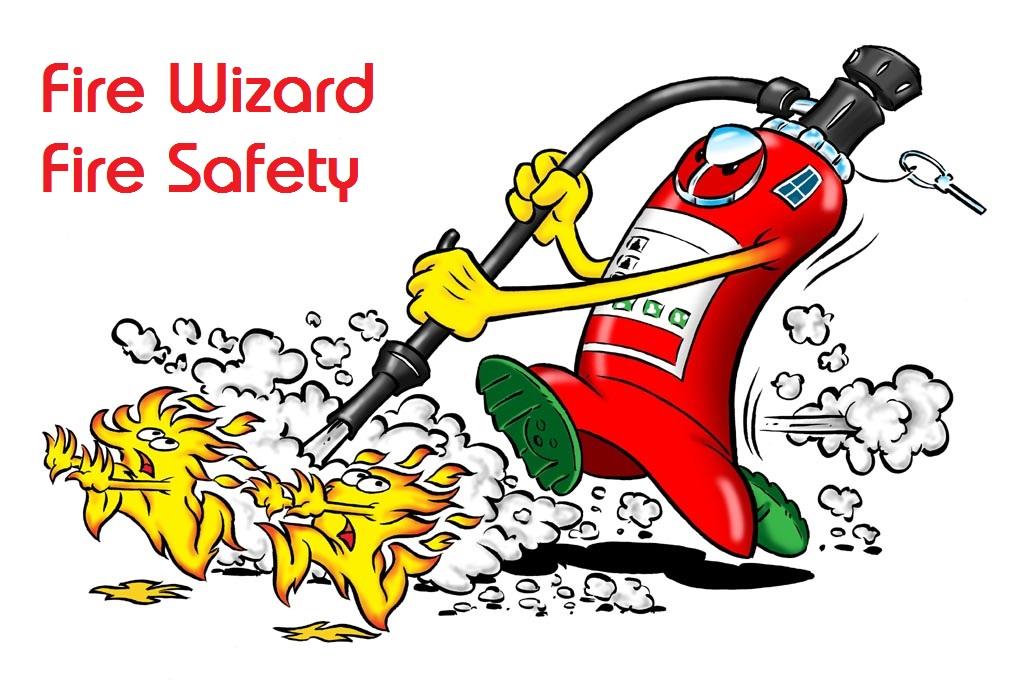

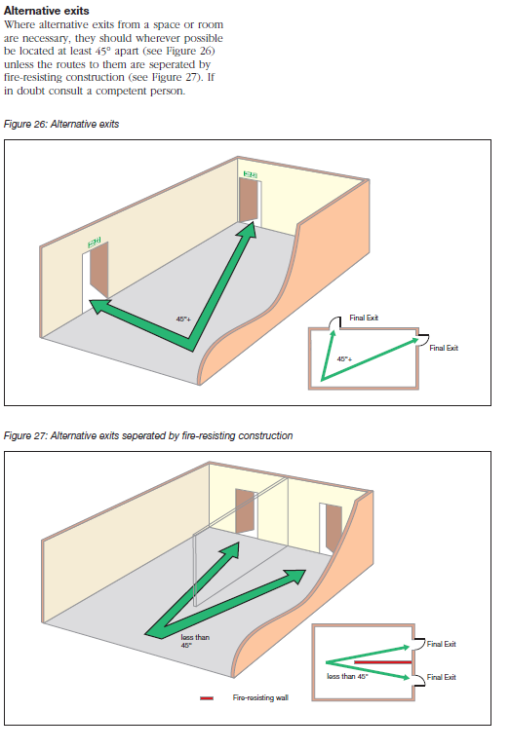
New Landlord Flat over Dog Grooming Salon
in Landlords
Posted
You can't - there is no 'magic barrier' - either apply a solution from above or below. Or install a full BS5839-1 (not domestic) fire alarm system to the ground floor with call points, sounders and detection that also has sounders in the flat and operate a full evacuate policy for the whole building.